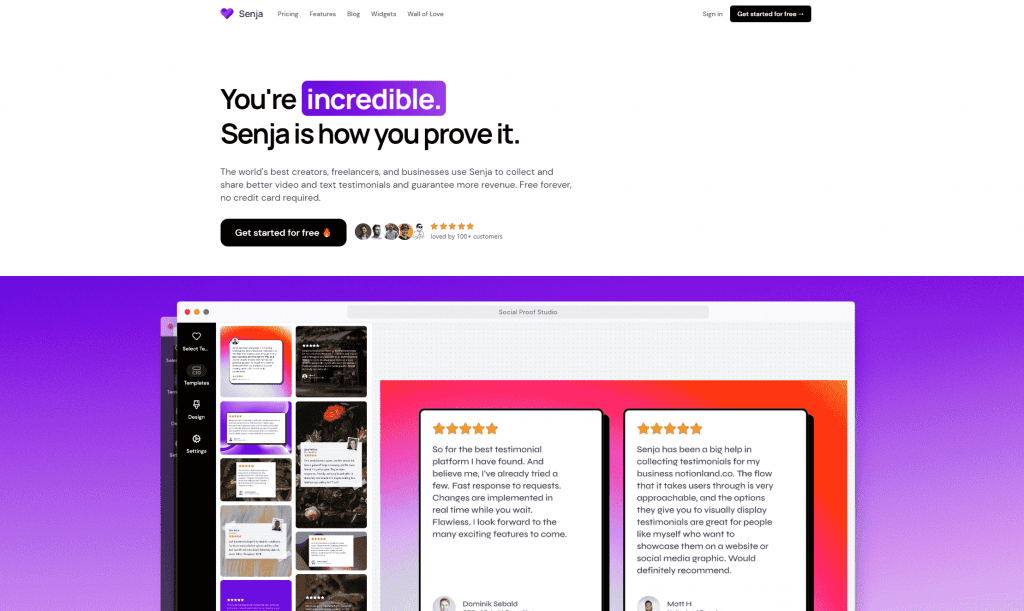The Complete Guide To Validating Your Business Idea
Validating your new business idea is the number one way to help your business succeed.
I’ve learnt this lesson the hard way.
Back in September 2021, I started to work on my first tech startup, Status Hive. I built the product in secret for months, scared that if I asked anyone about it, my idea would be stolen. Once I was finally happy, I launched my product and it flopped.
As I hadn’t talked to any of my target audience, or even done much competitive analysis, it turned out that I’d created a feature-lacking expensive product that no one wanted. Not a great start to my entrepreneurship journey!
And now, after launching several successful startups, I’ll delve into the process of validating your startup so you don’t make the same mistakes I did when starting out.
If you’re just starting out on your entrepreneurial journey, I’d recommend you read my complete guide to coming up with a business idea to increase your chances of coming up with an idea that is solid BEFORE you validate it.
Before we get started, if you’re starting your own SaaS business, I’d recommend having a look at Rob Walling’s great video on how to validate a saas idea before continuing to read this article.
What is Validation?
Validation is the process of determining whether your product idea is worth pursuing.
In other words, validation is about testing your assumptions on the market and proving that people would be willing to spend money on your product.
Can You Achieve 100% Validation?
In short, no.
It’s impossible to achieve 100% validation for any product idea as there’s always a degree of uncertainty involved. Even if you receive positive feedback from over 100 people (which would be a great sign of success), there’s no guarantee that your product will be successful in the market.
How Should I Validate My Business Idea?
At its core, validation requires you to talk to your target audience and understand whether your idea addresses their pain points and the features that they need your product to have.
If you’re not sure who the target market is for your business, I’d recommend you have a look at my in-depth guide here.
In my experience, there are 3 common ways to validate your startup idea:
- Having in-person (or online) conversations with your target audience
- Getting your target audience to complete surveys
- Using a landing page
I’m going to cover all 3 options in more detail below to help you make up your mind about which one to choose.
Conversational Validation

Conversational validation is my favourite way to validate a product idea.
It involves engaging in one-on-one conversations with potential customers, either in-person or online through video conferencing apps.
This high-touch approach involves directly engaging with potential customers to understand their needs, pain points, and preferences in order to validate your product idea, which means that you get complete control of the conversation and can more deeply understand your customers.
Why Is Conversational Validation So Great?
While conversational validation can take quite a bit longer than the other methods that I’m going to mention, it’s my favourite method because of the amount of quality information you’ll get.
When I realised that my own product, Status Hive, was not hitting it off well with my target market, I conducted some conversational validation with my network to see if there was anything that I could do to get customers to use my app. Here’s one response that I received which told me everything I’d need to know to completely abandon the idea.
While I do really like the idea of Status Hive, there are a lot of other products available in the market that offer similar features at a lower cost. I know that the business I work for generally opts for more established and widely trusted brands, as reliability and scalability are crucial for us. While Status Hive has its merits, I’d be more comfortable going with a bigger name in the industry to ensure seamless performance and support.
Participant of my conversational validation study after I launched Status Hive
On top of gaining a tonne of valuable information, if you get a positive response from a potential client (unlike me on this occasion), then it can help you to build a relationship with the potential customer.
By engaging in conversations with them, you show that you are genuinely interested in their needs and opinions. This can prove to be invaluable when it comes to launching your product, as customers are more likely to pay for your product and forgive any teething issues if they’ve already had a one-on-one conversation with you.
Survey Validation
As a slightly lower-effort alternative to conversational validation, you can use surveys to collect feedback from your target audience.
While I wouldn’t recommend that you solely use survey results to validate your startup idea (as people are often much less committed to the answers they give on an online form), they can be an incredibly valuable way to perform SaaS lead valdation due to the sheer volume of responses that you can get.
To get started with validating your startup using surveys, I’d recommend that you follow the following steps:
- Identify your target audience: Before conducting surveys, you need to know who your potential users are. I’ve created a complete guide to identifying your target audience if you need a hand with this.
- Create Clear Questions: You need to ensure that your questions are straightforward, concise, and easy to understand. Avoid leading questions that might bias responses and focus on extracting the key insights related to your startup idea.
- Find Your Survey Channels: Look at where your target audience hangs out and post your survey there. This could include Facebook groups, Subreddits etc.
- Analyze Your Results: Once you’ve collected survey responses, analyze the data to draw meaningful conclusions. Look for patterns, trends, and commonalities in the feedback. Pay attention to both quantitative data (e.g., ratings, rankings, and multiple-choice responses) and qualitative data (e.g., open-ended comments).
Landing Page Validation

Landing page startup validation is another great low-touch method for validating your product as it allows you to test the market demand for your product before investing significant resources into product development or cold outreach.
Put simply, landing page validation involves creating a homepage for your product online, including all of the marketing copy that you need to sell your product.
Most importantly, your landing page should include a form to capture user emails so that they can register their interest. Not only does this give you the emails of warm leads, meaning it’ll be much easier to drum up interest when you launch your product, but it will also allow you to measure the number of people who are interested in your product, allowing you to validate your startup idea!
While this method doesn’t immediately give you specific user feedback, I’d encourage you to get in contact with some (if not all) of the people who registered an interest with a survey or meeting invite so that you can learn more about their needs before developing your MVP.
How Do I Get People To Visit My Landing Page?
The main challenge with this method of validation is that you need to get people onto your website. This is harder than you might think.
While I have created a full 5-part series to dramatically increase the traffic to your website using SEO, this process takes many months to become properly effective. As such, I’d recommend you use one of my below methods to drum up some initial traffic while you’re validating your idea.
As well as using pay-per-click ads from services such as Google Ads, one of the best ways to market your landing page is to locate where your target audience spends their time and communicate with them there. This could be either on forums, Slack communities or live events.
If you’re struggling to find places to connect with your audience, check out the links at the bottom of this guide to launching your product.
Which Option Should I Choose?
Why not both?!
Validation is all about getting as many people to see your product as possible and making sure that they’re interested in purchasing your product. With the products I’ve launched in the past, I’ve tried to reach out to individuals first (both warm and cold connections) and get them to say yes to purchasing my product idea. After I’ve had a few yes responses, I start working on creating a landing page and email list by driving traffic to the site using a mixture of display ads and excellent blog articles. I then follow this checklist on what to do next when launching my startup.
FAQs
Should I Create An MVP Before Validating My Idea?
It’s generally a good idea to validate your idea before creating an MVP (Minimum Viable Product) as validation can help you determine whether there’s a market for your product and what features are most important to your target audience. This information can be invaluable when it comes to developing your MVP, as you can focus on only building the features that are useful to your target market.By validating your idea first, you can also avoid wasting time developing a product that nobody wants. It’s really common for entrepreneurs (especially first-time founders) to spend months or even years building a product only to realise that there’s no demand for it after they’ve finished building. Validation can help you avoid this scenario by allowing you to make an informed decision about whether to proceed with product development.That being said, there are some cases where creating an MVP first can be beneficial. If your product idea is an innovation in the industry, it may require an MVP to validate the technical feasibility to your potential customers.Ultimately, the decision to create an MVP before or after validation will depend on the nature of your product and the industry you’re working in. However, in most cases, it’s a good idea to validate your idea before investing significant resources into product development.
What's The Difference Between Cold and Warm Validation?
Cold validation involves reaching out to potential customers who have no prior knowledge or connection to your startup.For example, you might reach out to people on social media, through cold emails or through online forums to gather feedback on your startup idea. Cold validation is useful for getting unbiased feedback from people who have no preconceived notions about your product.Warm validation, on the other hand, involves reaching out to people who have some prior knowledge or connection to your startup. This might include friends or people in your professional network who you have shared your idea with. Warm validation is useful for getting feedback from people who already have some level of trust and familiarity with you and your product idea.
Which Is Better, Warm Or Cold Validation?
Both cold and warm validation have their pros and cons.Cold validation can be useful for getting unbiased feedback from a wide range of people who have no connection to your startup. However, as you’re reaching out to people who have no connection with you, it can be more challenging to get people to actually get in touch with you, meaning that you get fewer responses.Warm validation, on the other hand, can allow you to get much more feedback more quickly, as people already know and trust you. However, people who know you are much more likely to provide you with biased feedback as people may be unwilling to criticise your idea.Overall, both warm and cold validation can be effective ways to validate your new startup idea. We’d recommend using a mixture of warm and cold validation to ensure that you get a large amount of high-quality feedback about your product.
Key Takeaways
- Validation is Crucial: Validating your new business idea is essential to increase your chances of success. Neglecting validation can lead to costly mistakes, as demonstrated by the author’s own experience with their startup, Status Hive.
- Avoid Secrecy: Don’t keep your idea a secret out of fear that it might be stolen. Instead, actively seek feedback and input from your target audience and industry experts to refine your concept.
- Validation Defined: Validation is the process of determining whether your product idea has real market potential. It involves testing your assumptions and confirming that people are willing to spend money on your product.
- No 100% Guarantee: While validation is critical, it’s impossible to achieve 100% validation for any product idea due to inherent uncertainties in the market. Even positive feedback from many people doesn’t guarantee success.
- Methods of Validation:
- Conversational Validation: Engaging in one-on-one conversations with potential customers provides in-depth insights into their needs and preferences.
- Survey Validation: Surveys are a useful tool for collecting feedback from a larger audience. They can complement other validation methods.
- Landing Page Validation: Creating a landing page with a sign-up form helps gauge market interest and collect emails from potential customers.
- Choosing Validation Methods: Consider using a combination of validation methods to maximize your chances of success. Start with conversations to gain deep insights, then use surveys and landing pages to reach a broader audience.
- Marketing Your Landing Page: Getting people to visit your landing page can be challenging. Utilize pay-per-click ads and engage with your target audience where they congregate online.
- Continuous Improvement: Even after initial validation, stay open to feedback and be prepared to iterate on your product based on customer insights.
- Explore Further Resources: If your idea doesn’t gain traction during validation, consider exploring resources for coming up with a new startup idea and creating a successful startup.
Overview
Now that you’ve validated your idea, it might be time to start working on getting your first 100 customers.
However, if your validation showed that people aren’t as interested in your product as you first thought, check out our guide to coming up with a great startup idea and how to create a successful startup.







